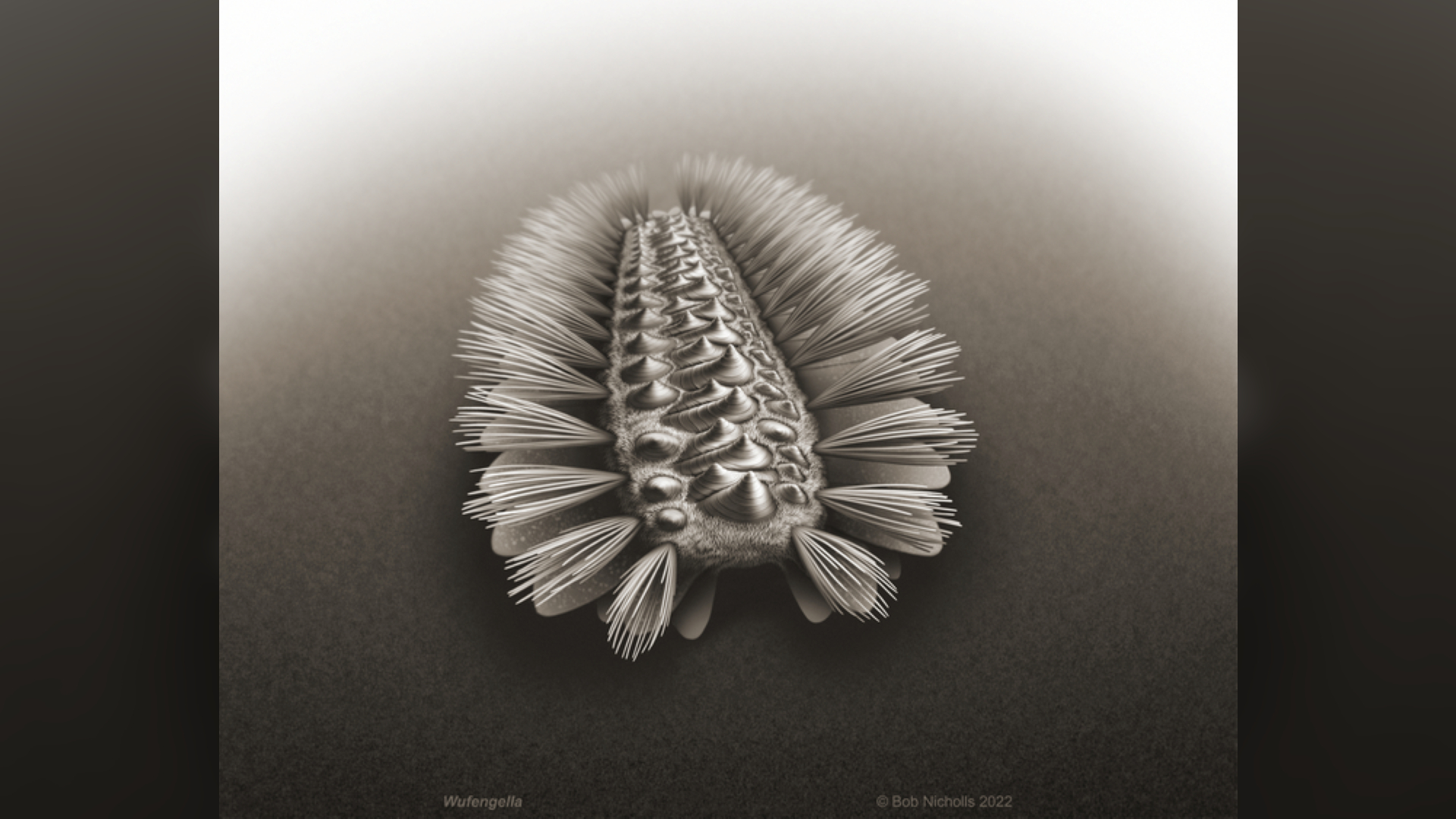Ancient armored 'worm' is the Cambrian ancestor to three major animal groups
The shelled worm is a tommotiid called Wufengella bengtsoni.

A bristly armored "worm" that scuttled across ocean reefs 518 million years ago is the ancestor to three aquatic animal groups that today live very different lifestyles, and it offers new clues about the explosion of diverse species at the time, a new study finds.
An international team of researchers recently discovered the fossil of a species that gave rise to brachiopods, bryozoans and phoronids; these three groups of filter-feeding marine creatures all fix themselves to the seafloor, but each group has highly specialized feeding structures and they look very different from one another. The fossil species, named Wufengella bengtsoni, is a member of an older, shelled group of organisms called tommotiids, scientists reported in a new study.
The find adds a new piece to the puzzle of how animals evolved during the Cambrian explosion, a time during the Cambrian period (541 million to 485.4 million years ago) when early life diversified rapidly on Earth, introducing and establishing a variety of different body plans that we still see in living animals today.
Brachiopods are shelled, bivalved creatures; bryozoans are soft-bodied with crowns of tentacles, and phoronids are encased in protective tubes made of chitin, a material that reinforces organic structures such as exoskeletons, beaks and shells. Prior to the discovery of W. bengtsoni, taxonomists had speculated that the ancestor of all these animal groups could have been a segmented worm-like tommotiid, based on similarities in the groups' embryonic development in living animals. But while researchers had some idea of what this hypothetical ancestor might look like, they weren't sure if they'd ever find it.
"One of the things that we often mentioned when we were sitting in the pub and fantasizing about what we could hope to potentially find one day was this elusive tommotiid," co-author Jakob Vinther, an associate professor of macroevolution at the University of Bristol in England, told Live Science.
Related: Flecks of silver in poop of ancient Cambrian creature baffle scientists
The fossil was found at the Chengjiang Biota fossil site in Yunnan, a province in southwestern China. It's a rare find because animals such as this are typically not preserved well enough for paleontologists to study them in detail.
Sign up for the Live Science daily newsletter now
Get the world’s most fascinating discoveries delivered straight to your inbox.
"They were scuttling around on reefs in the shallow tropical waters that existed back then," Vinther said. In these ancient reef systems, dead animals usually were washed around until their bodies disintegrated, and their soft tissues often decayed in the reefs' oxygen-rich waters before fossilization could happen. "This particular animal, lucky for us, got washed down into deep water where it got buried in mud where it was preserved," Vinther said.
While the researchers predicted W. bengtsoni's general body plan, some features in the fossil were a big surprise. It had flaps on its body that could have been used for suction purposes, to fix the animal to the reef when there were waves, Vinther speculated The species also had long bristles on its sides that may have been used for sensing prey or as protection against predators. The study authors aren't sure what the animal ate, but its body wasn't adapted for filtering water or staying still, so they know it wasn't a filter feeder that attached to the seafloor like its descendants.
The researchers are confident that it is the ancestor of brachiopods, bryozoans and phoronids because it shared a similar skeleton with those groups. As life evolved in the Cambrian explosion, animals filled different ecological niches and adopted different body plans. "Sometimes ancestors may look altogether very, very different from their closest living relatives," Vinther said.
Martin Smith, an associate professor of paleontology at Durham University in England who was not involved in the study, described the new research as an "impeccably executed" example of science. "It's a fantastic study," Smith said.
"We're really seeing how these groups fit together, and how they evolved from a single common ancestor. It's taking us up a rung in the evolutionary tree," Smith added. "It's the next frontier, we're going that little bit deeper in deep time and we're really starting to see the origin of the Cambrian explosion when all the complex body plans appear."
The study was published online Sept. 27 in the journal Current Biology.

Patrick Pester is the trending news writer at Live Science. His work has appeared on other science websites, such as BBC Science Focus and Scientific American. Patrick retrained as a journalist after spending his early career working in zoos and wildlife conservation. He was awarded the Master's Excellence Scholarship to study at Cardiff University where he completed a master's degree in international journalism. He also has a second master's degree in biodiversity, evolution and conservation in action from Middlesex University London. When he isn't writing news, Patrick investigates the sale of human remains.









